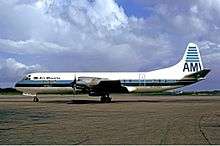Air Manila Flight 702
 An Air Manila Lockheed L-188 Electra, similar to the one that crashed | |
| Accident | |
|---|---|
| Date | 4 June 1976 |
| Summary | Engine failure followed by pilot error |
| Site |
Southwest Naval Air Station Agana 13°29.5′N 144°49′E / 13.4917°N 144.817°ECoordinates: 13°29.5′N 144°49′E / 13.4917°N 144.817°E |
| Aircraft | |
| Aircraft type | Lockheed L-188A Electra |
| Operator | Air Manila |
| Registration | RP-C1061 |
| Flight origin | Naval Air Station Agana |
| Destination | Ninoy Aquino International Airport |
| Passengers | 33 |
| Crew | 12 |
| Fatalities | 45 (all), plus one on the ground |
| Injuries | 2 (on the ground) |
Air Manila Flight 702 was an unscheduled passenger flight from Naval Air Station Agana in Guam to Ninoy Aquino International Airport in Manila, carrying 33 passengers and 12 crew members; most of whom were personnel from the base. The Lockheed L-188A Electra attempted takeoff from runway 6L but crashed near a residential area; the crash was caused by retracting the flaps at an altitude too low to clear the terrain after the propeller of engine number three feathered. All 45 people on board and one person on the ground perished in the crash. The investigation concluded that the pilot should have followed company policy by aborting takeoff in the event of an engine failure before reaching VR (takeoff) speed.[1][2]
Aircraft
The aircraft involved in the accident was a Lockheed L-188A Electra with four Allison 501-D13 engines, registered RP-C1061 to Air Manila International at the time of the accident. The aircraft made its maiden flight in 1958, then registered to Eastern Airlines as N5502. The aircraft was then sold to Air Manila on November 30, 1971. Maintenance records showed the transponder listed as "inoperable." Engine No.2 to be shut down en route to Guam due to mechanical issues; several pilots reported issues with the No.3 engine in the maintenance log before the crash.[2][3]
Crew
Twelve crew members were on board flight 702 when it crashed; four members of the flight crew, the loading master, two mechanics, and four flight attendants.
The cockpit crew consisted of:
- Captain Roberto Javaleva, who worked for Air Manila since 16 September 1964, served as pilot in command on the flight. A veteran pilot, having logged 10,016 total flight hours, roughly 2,422:45 of which were accumulated flying Lockheed L-188A Electras, was age 46 at the time of the accident. His license to operate Lockheed L-188A Electras was valid from March 1, 1976 to August 31, 1976. He was required to wear glasses for far-sightedness as needed in flight but this was not a factor in the crash.
- First Officer Ernesto Nacion served as co-pilot, 40, who worked for Air Manila since 17 April 1968. His pilot's license was valid from January, 1976, to 30 June 1976. Nacion was certified to be a reserve captain for the L-188 Electra on 10 March 1975. At the time of the accident he had 8,906:44 total flight hours, of which 2,037:21 were on the L-188 Electra.
- Flight Engineer Johnathan Javaleva, 32, who worked for Air Manila since 28 February 1969.
- Relief Officer Salvador Bello, 33, who worked for Air Manila since 1 February 1970.
Synopsis
Air Manila flight 702 crashed while attempting to takeoff from runway 6L of Naval Air Station Agana at 14:47 Greenwich time on 4 June 1976. Seconds after lifting off from the runway the No. 3 propeller feathered. Witnesses reported that the plane lifted off the runway near the 7,500 marker of the 10,015 foot runway; also noting that despite the one feathered propeller the takeoff seemed normal. After the failure the plane flew at varying altitudes between 75 and 100 feet for a while, then flew level for 1,600 feet before crashing into terrain past the end of the runway; dragging across a hill, pushing through a chain link fence, and striking a car on the highway before stopping in a vacant before exploding. All 45 people on board plus the driver of the car struck by the aircraft were killed. Two people who lived near the crash site suffered severe injuries from the explosion.[2]
Causes
The primary cause of the accident was the flight crew's inappropriate response to the engine failure. The captain continued flight with the engine failure despite safely being able to abort takeoff, having not yet reached VR speed. The NTSB reported the causes of the accident as:
"The loss of climb capability after the crew retracted the flaps at too low an altitude to clear the rising terrain. The flaps were retracted after the number 3 propeller feathered as the aircraft lifted off the runway. Contributing to the accident was the captain's decision to continue the take-off after an engine failed before reaching the rotation speed."[2]
References
- ↑ Ranter, Harro. "ASN Aircraft accident Lockheed L-188A Electra RP-C1061 Guam-Agana NAS (NGM)". aviation-safety.net. Retrieved 2017-03-22.
- 1 2 3 4 "AIRCRAFT ACCIDENT REPORT AIR MANILA, INCORPORATED, LOCKHEED 1-188A REPUBLIC OF THE PHILIPPINES REGISTRY RP-C1061" (PDF). National Transportation Safety Board. September 26, 1977. NTSB/AAR-77-06. Retrieved March 22, 2017.
- ↑ "Registration Details For RP-C1061 (Air Manila International) L-188 Electra-A - PlaneLogger". www.planelogger.com. Retrieved 2017-03-22.